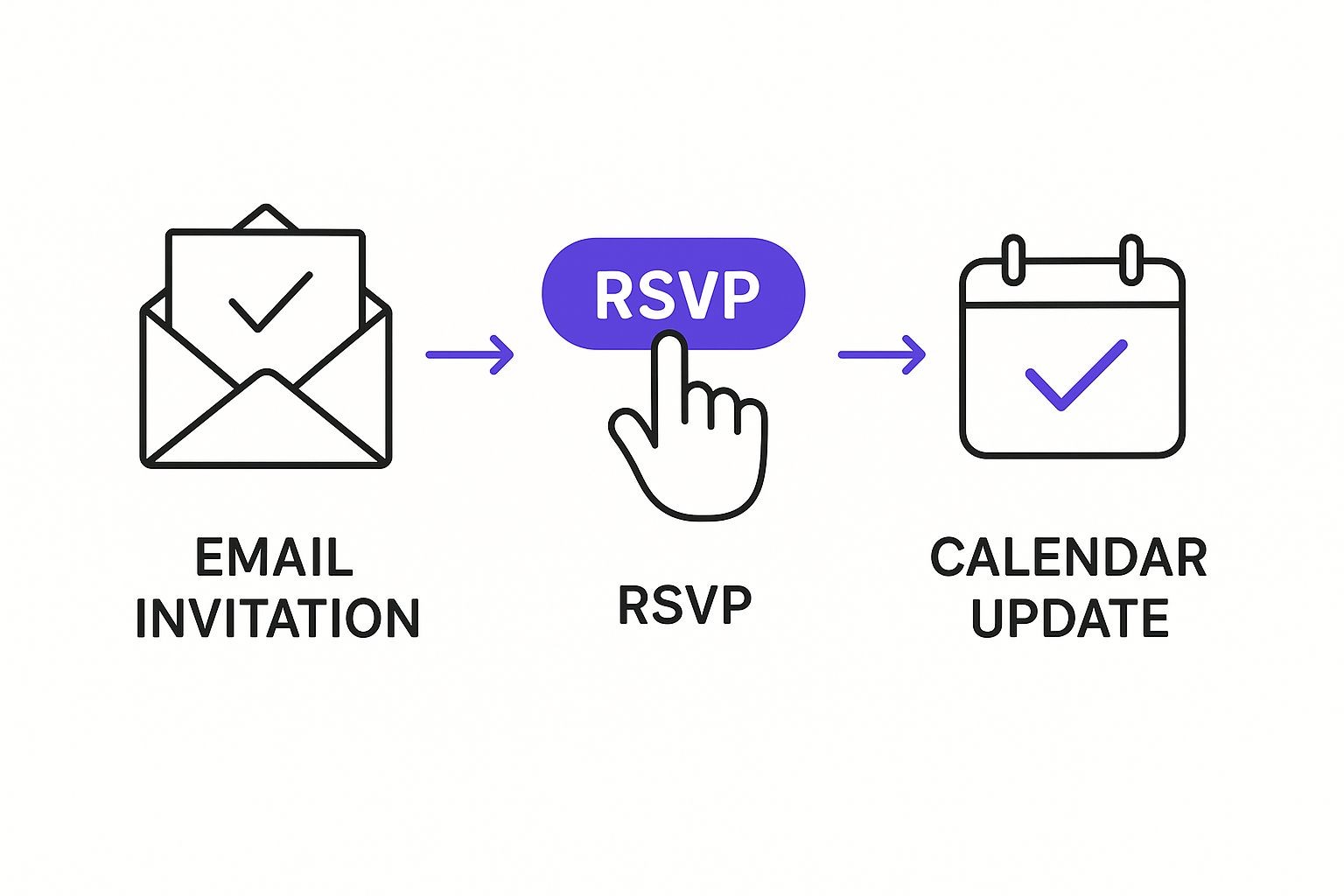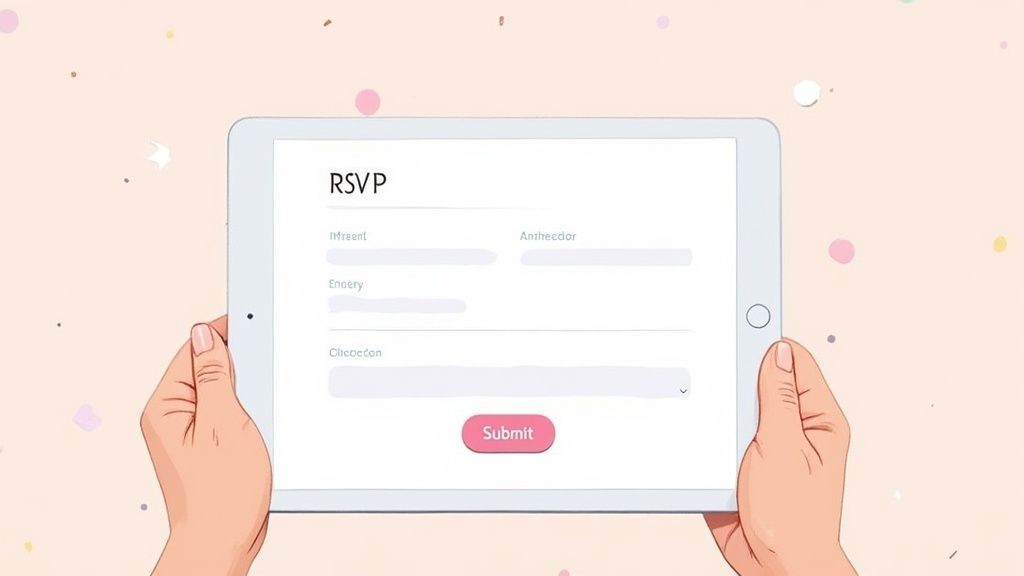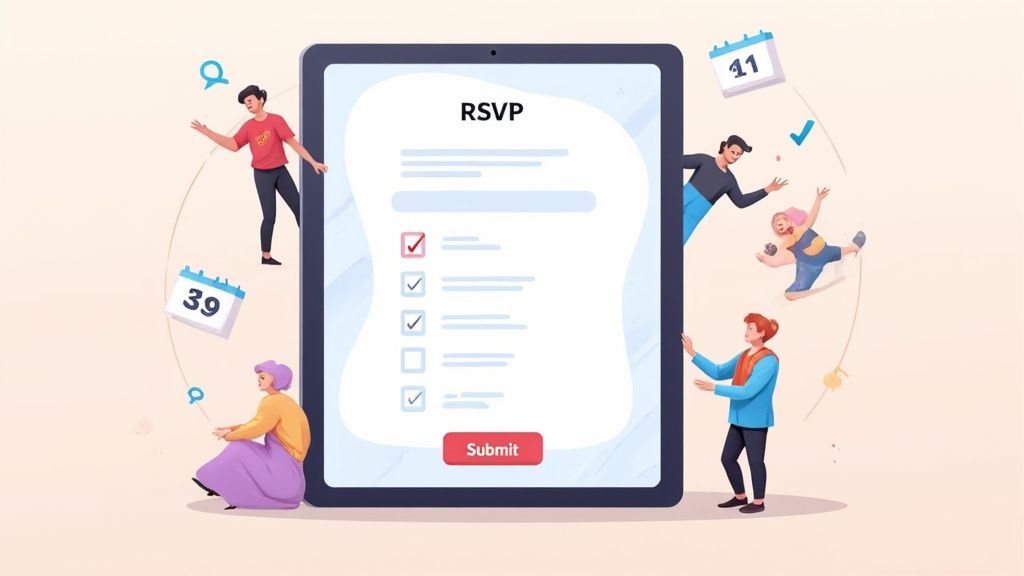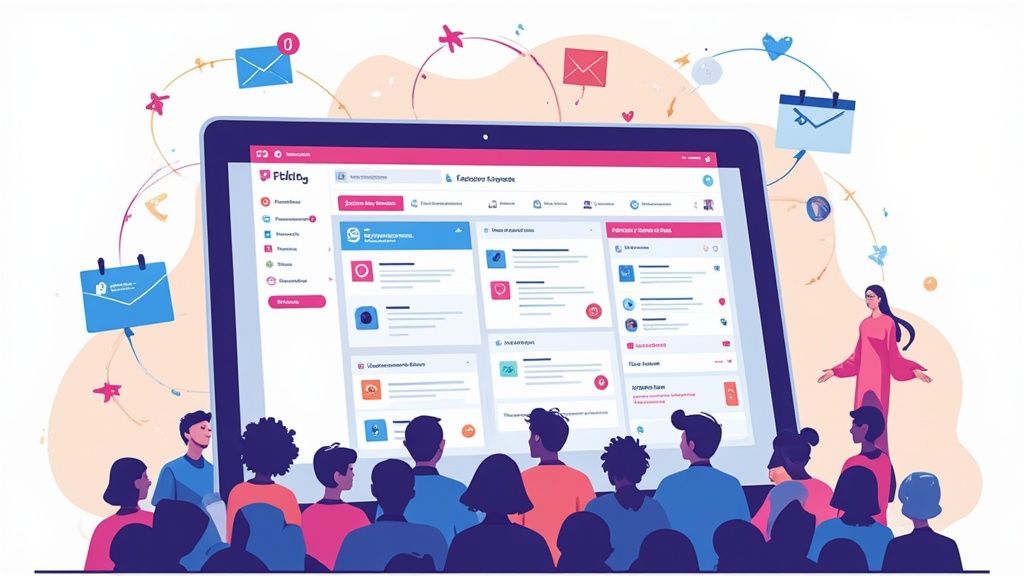Online RSVP services are, at their core, digital tools built to simplify and automate the process of collecting event responses. Think of them as the modern replacement for old-school paper cards and chaotic spreadsheets, giving you a clean, real-time dashboard of your guest list.
What Are Online RSVP Services Really For
Ever tried to cook a big dinner in a kitchen where you can't find anything? Ingredients are everywhere, you're missing the right pan, and you're not even sure how many people are coming. That's exactly what managing event responses feels like without a proper system - a mad dash through emails, texts, and misplaced paper replies.
An online RSVP service is your professionally organized kitchen. It brings order to the chaos and turns a stressful chore into a smooth, controlled process.
But these platforms are so much more than just a digital button for guests to click "yes" or "no." They're the command center for your entire event, built to solve the most nagging problems every organizer runs into.
Solving Core Event Management Challenges
The real magic of these services is how they tackle the critical pain points that can make or break an event. By putting all your guest communication and data in one place, they give you clarity and control from the first invitation to the final headcount.
Here are the key problems they just make disappear:
- Inaccurate Headcounts: No more guessing games. You get a live, accurate count of who’s coming, which is absolutely crucial for catering, seating charts, and sticking to venue capacity.
- Communication Gaps: These tools become your single source of truth. Need to send an update, a reminder, or last-minute details? You can hit everyone at once, ensuring nobody is left out of the loop.
- Administrative Burnout: They automate all the tedious stuff - tracking who has (and hasn't) replied, sending follow-ups, and compiling guest lists. This frees you up to focus on what really matters: creating an amazing experience.
From Simple Yes/No to a Complete System
At their heart, these tools are all about turning fuzzy uncertainty into solid, actionable data. They're a foundational piece of modern event planning and often fit into a bigger ecosystem of tools.
In fact, you'll see a lot of overlap between online RSVP services and broader platforms, which you can read more about in our guide on what is event management software. This integration is what makes them so powerful.
The move to digital isn't just a trend; it's a huge shift in the market. Just look at the global wedding stationery market, which includes these online platforms. It was valued at USD 0.88 billion in 2024 and is expected to nearly double by 2033. This explosion in growth shows just how much people prefer efficient, digital tools for their events.
Ultimately, an online RSVP service is your event's central nervous system. It gathers information, coordinates communication, and ensures every decision you make is based on real-time, accurate data. The result? Smoother, more successful events, every time.
Decoding the Must-Have RSVP Platform Features
So, you're sold on the "why" of an online RSVP service. The next big question is "what?" What separates a decent platform from one that will become your event-planning secret weapon? It’s a bit like choosing a new smartphone. They all make calls, but the one you really want is the one with the intuitive interface, killer apps, and features that just make your life easier.
The same logic applies here. The core job is getting a simple "yes" or "no," but the real magic is in all the features built around that one little action.
The journey from sending an invite to seeing a guest’s name on your confirmed list involves a few critical steps. Think of it as a bridge connecting your announcement to their attendance.
This is the basic flow your RSVP tool needs to nail.

Each stage of this process depends on specific platform features to keep things running smoothly for everyone involved - you and your guests. Let's break down the big ones.
Customizable Invitation and Form Design
You know what they say about first impressions. Your invitation is the very first touchpoint for your event, and it needs to look the part. A great RSVP tool gives you the power to create something that feels like you, not a generic template.
This goes way beyond just changing a few colors. You should be looking for a service that lets you:
- Own your brand: Upload your logo, use your specific brand fonts, and dial in your exact color palette. It should look like it came straight from you.
- Ask the right questions: Every event has unique needs. Need to know about dietary restrictions for a gala? T-shirt sizes for a company offsite? Meal choices for a wedding? Your form needs the flexibility to ask anything.
- Build forms in steps: For bigger, more complex events, you might not want to overwhelm guests with a giant form upfront. The ability to ask for basic info first and gather more details later is a huge plus.
This level of control means you get the precise information you need while making your event look polished and professional from the get-go.
Smart Guest List Management and Communication
Here's a hard truth: managing a guest list is so much more than just counting heads. It's about knowing who's coming, how to talk to them, and juggling all the little details that pop up. This is where a powerful dashboard becomes your command center.
A top-tier platform will give you tools for:
- Easy Importing and Exporting: You shouldn't have to manually re-enter hundreds of names. The ability to upload a spreadsheet of guests and later export the final attendee list is non-negotiable.
- Plus-One and Group Tracking: Your system needs to handle guests bringing a partner or their family without you having to do manual math. It should just work.
- Automated Reminders and Updates: This feature is an absolute lifesaver. You can schedule reminders to go out a week before, or even the day of, to dramatically cut down on no-shows. Industry data suggests about 17% of invited guests will decline, but forgetting is another issue entirely. A gentle, automated nudge keeps your event from slipping their mind.
A well-managed guest list is the backbone of any successful event. The right online RSVP service automates the tedious work of tracking and communication, freeing you to focus on creating an unforgettable experience.
Seamless Calendar and App Integrations
Let's be real. In today's world, if an event isn't on someone's calendar, it might as well not be happening. The space between a guest clicking "Yes" and actually walking through the door is often just a simple matter of memory.
This is where integrations become absolutely critical.
The most important integration for any online RSVP service is a dead-simple "Add to Calendar" function. At our company, we’ve built our entire service around this simple, powerful idea. When a guest confirms, giving them a one-click option to pop the event straight into their Google Calendar, Outlook, or Apple Calendar is paramount. That one click turns a vague intention into a scheduled commitment.
Beyond that, you'll want to look for connections to the other tools in your arsenal:
- Email Marketing Platforms: Syncing your attendee list with a service like Mailchimp means you can send out beautiful, targeted email campaigns without a hassle.
- CRM Systems: For business events, automatically piping new leads from your attendee list into your CRM is a massive time-saver.
- Zapier or Make: These are the Swiss Army knives of automation, letting you connect your RSVP tool to thousands of other apps for any custom workflow you can dream up.
These integrations elevate your RSVP platform from a simple tool to the central hub of your event operations.
Core Feature Checklist for Online RSVP Services
Feeling overwhelmed by the options? Use this quick-reference table to compare essential features and figure out which platform is the right fit for your event.
| Feature Category | Must-Have Functionality | Impact on Event Success |
|---|---|---|
| Customization | Logo upload, custom colors/fonts, custom form questions | Reinforces brand identity and ensures you collect the specific info you need. |
| Guest Management | Spreadsheet import/export, plus-one tracking, group RSVPs | Saves countless hours of manual data entry and prevents headcount errors. |
| Communication | Automated reminders, confirmation emails, targeted messaging | Drastically reduces no-shows and keeps guests informed and engaged. |
| Integrations | One-click "Add to Calendar," email/CRM sync, Zapier support | Transforms a "yes" into actual attendance and connects your event to your workflow. |
| Reporting | Real-time response tracking, attendee data export, basic analytics | Provides a clear picture of your headcount and attendee demographics at a glance. |
Ultimately, the best platform is one that not only collects responses but also helps ensure those "yeses" translate into actual attendance. To see how these features come together in a real-world tool, you can explore the functionality of an integrated RSVP system right on our features page.
Choosing the Right Online RSVP Service

Picking the right online RSVP service can feel like staring at a wall of TVs at an electronics store. They all look pretty similar from a distance, but the little details - the features, the price, the user experience - make all the difference.
The best choice simplifies your life, while the wrong one can cause more problems than it solves.
There’s no single "best" platform. The right tool for a 200-guest wedding is completely different from what a small business needs for a weekly webinar. It all comes down to matching the service’s features to your event’s needs, your budget, and how comfortable you are with the tech side of things.
Let's walk through the decision process for three very different event organizers. Seeing what matters to them will shine a light on what you should be looking for.
The Wedding Planner's Dilemma
First up is Sarah, a wedding planner deep in the details of a large, elegant wedding. For her, the guest experience is everything. Aesthetics are not optional; they're essential. She needs a tool that feels as premium as the event itself.
Here’s what’s on Sarah’s must-have list for an online RSVP service:
- Elegant Customization: The RSVP page can't just be a generic form. It has to perfectly match the wedding's theme, with full control over fonts, colors, and the overall design.
- Detailed Guest Management: Sarah needs to track way more than just "yes" or "no." She's managing meal choices, plus-ones, and even RSVPs for other events like the rehearsal dinner.
- Reliability: With 83% of invited wedding guests likely to attend, there's zero room for error. Accurate numbers are critical for catering and seating charts.
Sarah is going to lean toward dedicated wedding platforms or the premium tiers of major services. For her, the ability to create a polished, seamless experience is worth the higher price tag.
The Corporate Event Coordinator's Needs
Next is David, a marketing manager running his company's annual conference. His goals are all about efficiency, data, and professionalism. He’s less concerned with romantic fonts and more focused on powerful, functional tools.
David is hunting for a platform that can handle:
- Branding and Integration: The RSVP page must look like it belongs to his company, with their logo and brand colors. Crucially, it needs to talk to their CRM for lead capture and their email marketing platform.
- Ticketing and Payments: The conference isn't free. He has early-bird tickets, VIP packages, and different pricing tiers, so secure payment processing is a must.
- Multi-Session Registration: Attendees need to sign up for specific breakout sessions. David has to track the headcount for each one to avoid overbooking rooms.
David will skip the simple form builders and go straight for a business-focused service. He needs a system built for corporate logistics, with robust ticketing and integration capabilities.
The Small Business Owner's Focus
Finally, meet Maria, who runs a local yoga studio. She hosts weekly workshops and just needs a simple, affordable way for her clients to sign up. Her priorities are ease of use and cost. She doesn't have a big budget or the time to wrestle with a complex platform.
Maria’s ideal service is straightforward and scalable. It should handle a small workshop of 15 people as easily as a larger community event, growing with her business without a massive jump in cost or complexity.
As a company, we see scalability as a huge deal. Your needs will change, and your tools should be able to keep up. Maria should look for a service with a generous free plan or a low-cost tier that covers the essentials. For her, a clean, mobile-friendly RSVP form she can link to from her social media is far more important than deep customization.
She could even build a simple event page to host her RSVP form. For anyone just starting out, we've outlined how to set up a free event website with RSVP capabilities to get going quickly and without any cost.
Ultimately, finding the right platform is about asking the right questions before you start looking.
Run through this quick checklist:
- Event Type: Is this a formal, corporate, or casual event?
- Guest Needs: What info do I absolutely need to collect from guests? (e.g., meal choice, t-shirt size)
- Technical Skills: Honestly, how much time do I want to spend on setup?
- Budget: What am I realistically able to spend per event or per month?
- Scalability: Will this tool still work for me a year from now if my events get bigger?
Answering these questions first will point you toward an online RSVP service that feels less like a random guess and more like the perfect partner for your event.
Turn RSVPs into Actual Attendees
Let’s be honest, an online RSVP tool isn't just for counting heads. When you use it right, it's your secret weapon for making sure people actually show up. The trick is to move beyond logistics and turn your RSVP process into an engagement engine that gets people genuinely excited for your event.
It all starts with the invitation. Stop just listing what the event is and start talking about the unique experience attendees will get. Create a bit of FOMO (Fear Of Missing Out) by highlighting exclusive content, a special guest speaker, or networking opportunities they absolutely can't get anywhere else.
Then, add a clear RSVP-by date. This simple deadline creates a sense of urgency and bumps your event to the top of their to-do list. Pair that with a few automated reminders, and you’ve got a solid system for making sure your invitation doesn't get buried in a crowded inbox.
The Annoying Gap Between "Yes" and "Showing Up"
Every event organizer knows the pain of the no-show. Someone clicks "yes" on the RSVP, and then… crickets. They just don't turn up. It's rarely malicious; life just gets in the way and people forget. This is where you can get smart with calendar integrations.
Think of an RSVP "yes" as a statement of intent. It’s a good first step, but it’s not a firm plan locked into someone's schedule.
The single most effective way to turn that intent into a concrete commitment is by getting your event onto their personal calendar. A calendar entry is a scheduled, blocked-out piece of their time, complete with its own reminders.
This is the exact problem we built our service to solve. By placing a simple "Add to Calendar" button right where they RSVP, you kill the friction between saying yes and actually scheduling it. In one click, a vague intention becomes a solid calendar entry, which dramatically cuts down the chances of someone forgetting.
The Magic of a Single Click
Think about the difference this makes. Without an easy "add to calendar" option, your guest has to manually open their calendar, create a new event, copy and paste all the details, set a reminder, and cross their fingers they got the time zone right. Let’s be real - most people just won't bother. Their attendance is left up to memory.
An integrated button replaces that entire clumsy process with a single, satisfying click.
- It makes the commitment real: The event is now officially part of their schedule.
- It uses their own tools against forgetfulness: Their phone or computer will now send them notifications, acting as a personal assistant.
- It removes all the work: No details to copy, no addresses to look up, and no time zones to wrestle with.
This isn't just a nice-to-have; it's becoming critical, especially with so many virtual and hybrid events. The latest numbers show that 63% of event organizers are putting more money into virtual event tech, including online RSVP services, to keep people engaged. Since getting people to log on is the whole game, making it effortless for them to block off that time is a no-brainer. You can dig into more of the trends shaping the event industry to see just how vital these digital touchpoints are.
At the end of the day, a smart RSVP strategy isn't about collecting names on a list. It’s about using a little bit of psychology and some simple tech to make your event an unmissable part of your guest's schedule. You're not just hoping for a good turnout - you're actively engineering it.
The New Era of Virtual and Hybrid Events
The way we gather has changed. Big time. Not long ago, your biggest decision was which local venue to book. Now, you're juggling virtual summits, hybrid conferences, and global webinars. This isn't just a small shift; it's a seismic one that has pushed online RSVP services from a "nice-to-have" tool to the absolute core of event management.
Running an in-person event has its own set of headaches, sure. But once you throw a virtual or hybrid component into the mix, you've unlocked a whole new level of complexity. You’re not just managing a room anymore; you're orchestrating a digital experience for people scattered across every time zone imaginable.
This new reality brings a unique set of hurdles that your trusty old spreadsheet or basic email RSVP simply can't clear.
Navigating the Challenges of Digital Gatherings
At the end of the day, your job is still the same: create a seamless, professional experience for every single attendee. It’s just that the problems you need to solve have changed. Modern platforms have been forced to evolve to tackle these digital-first challenges head-on, making sure someone tuning in from their home office feels just as valued as someone in the front row.
Think about the new non-negotiables:
- Coordinating Across Time Zones: A simple "Starts at 9 AM" is a recipe for disaster when your guests are in New York, London, and Tokyo. A smart RSVP tool has to handle time zone conversions automatically. No excuses.
- Secure and Unique Access Links: For any paid or private virtual event, you can't just tweet out a public Zoom link and hope for the best. RSVP services now have to act as digital bouncers, distributing unique, secure access credentials only to those who are actually on the list.
- Segmenting Your Audience: In a hybrid event, you have two completely different audiences with different needs. You need a system that can tell the difference and send parking details to the in-person crowd and login instructions to the virtual one.
These aren't just fancy features anymore. They are the command center for delivering a polished experience to an audience that isn't in one place.
The Explosive Growth of the Virtual Event Market
If you think this is just a passing trend, the numbers tell a very different story. The global virtual events market - which runs on the back of online RSVP services - is on an absolute tear.
It clocked in at USD 199 billion in 2022, jumped to USD 236 billion in 2023, and is on track to hit USD 275 billion in 2024. But it doesn't stop there. Forecasts predict the market will rocket to an incredible USD 1.066 trillion by 2032. If you want to dig into the data, you can find more of these powerful virtual events statistics.
This kind of massive growth sends a clear message to every event organizer out there: getting comfortable with these digital tools isn't optional anymore. It’s a core skill you need to stay relevant in a world that’s only getting more digital.
To keep up, these platforms have to play nice with all the other tech that makes these online experiences possible.
The Power of Smart Integrations
To pull off a truly smooth virtual or hybrid event, your RSVP system can't live on an island. It needs to talk to your other essential tools, and this is where smart integrations make all the difference.
For example, a top-tier online RSVP service should plug directly into streaming platforms like Zoom, Vimeo, or Webex. When a guest hits "confirm," the system should automatically register them for the webinar and fire off their unique join link. All of this happens behind the scenes, without you lifting a finger. That kind of automation doesn't just save you a ton of time; it completely eliminates the chance of human error.
In this new era, your online RSVP service is the digital front door to your event. It's the very first impression and the central hub that connects your entire audience to the amazing experience you've worked so hard to create - no matter where on the planet they happen to be.
Common Questions We Hear About Online RSVPs
Once you start looking into online RSVP services, a few practical questions almost always come up. We've been there. You've narrowed it down, but now the "what ifs" start to creep in. Let's walk through some of the most common questions we hear from event organizers to clear up any confusion and get you moving forward with confidence.
Think of this as your quick-fire FAQ, based on real-world event planning headaches.
Are Free Online RSVP Services Good Enough for Professional Events?
This is a big one, and the honest answer is: it depends entirely on the event. For a casual team lunch or a quick get-together with friends? Absolutely. A free service will get you the basic "yes" or "no" you need, no problem.
But the moment you step into the professional arena - a corporate conference, a paid workshop, a high-stakes client dinner - the game completely changes. The investment in a paid platform stops being a "nice-to-have" and becomes a necessity for protecting your brand and ensuring a smooth guest experience.
Paid services typically bring a few non-negotiable features to the table:
- Custom Branding: Nothing screams "amateur" like an RSVP page plastered with another company's logo. You need the ability to use your own colors and branding to maintain credibility.
- Smarter Guest Management: This is where the real power lies. We're talking about things like tracking plus-ones, asking custom questions ("Which breakout session will you attend?"), and easily exporting guest data.
- Real Data and Reporting: Professional events need metrics. You have to know your attendance rates and other key data points to prove ROI and plan better for next time.
- Someone to Call for Help: When things go sideways right before an event (and they sometimes do), having access to dedicated support is a lifesaver.
While "free" is always tempting, the time you'll save, the polished image you'll present, and the sheer peace of mind you get from a paid service are almost always worth the small investment.
How Far in Advance Should I Send Digital Invitations?
Ah, the timing dilemma. Send it too early, and it gets buried in a crowded inbox. Send it too late, and everyone's already booked. The sweet spot really hinges on the type of event you're hosting.
The best trick is to work backward from your event date. Think about what you're asking of your guests. The more time, travel, or money they have to commit, the more lead time you need to give them.
Here’s a simple framework many organizers stick to:
- Big, Formal Events (Weddings, Major Conferences): For these, a "save the date" should go out 6-12 months ahead of time. The official invitation with the RSVP link should follow 6-8 weeks before the event. This gives people plenty of time to book flights and hotels.
- Corporate Events or Webinars: A standard business event usually just needs 3-4 weeks' notice. It’s far enough out for people to clear their calendars, but not so far that they forget about it.
- Small, Informal Gatherings: For a local workshop or a casual networking night, 2-3 weeks is perfectly fine.
The goal is to find that perfect balance between respecting your guests' time and creating a sense of urgency for your event.
What’s the Best Way to Handle Guests Who Miss the RSVP Deadline?
First off, don't panic. It's usually not personal. Life gets busy, inboxes overflow, and your event simply slipped their mind. A gentle, polite nudge is almost always all it takes to get a response.
Give it a day or two after the deadline passes, then send a personal follow-up. Please, don't send a generic, automated blast - a personal touch makes all the difference here.
Keep the tone positive and helpful. Instead of a scolding, "You missed the deadline," try something more like, "Hey, we're finalizing the headcount for our event next week and just wanted to make sure we have your response. We’d really love for you to be there!" It's friendly, non-accusatory, and makes it easy for them to reply without feeling embarrassed. Most people will appreciate the reminder.
Can These Services Handle Complex Events with Multiple Sessions?
Absolutely. In fact, this is where the more sophisticated online RSVP services really prove their worth and stand out from simple form builders. Many of today's platforms were built from the ground up to manage the messy logistics of multi-part events.
If you’re running a conference, a festival, or a multi-day corporate retreat, these tools are invaluable. They let you register people for the main event and allow them to sign up for individual workshops, breakout sessions, or specific tracks. This helps you manage room capacity, figure out resources, and even see in real-time which sessions are the most popular, so you can make smart decisions on the fly.
Ready to turn those RSVPs into actual, committed attendees? At our company, we built our service to close the gap between "yes" and "I'm here," combining powerful RSVP features with the one-click calendar integrations that make sure people show up.



